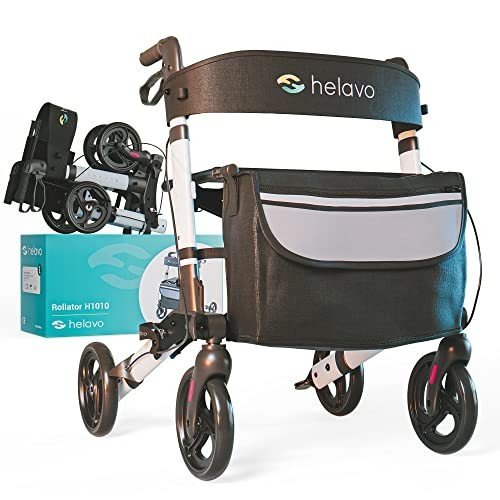indoor-walker5734
indoor-walker5734
See What Rollator For Walking Tricks The Celebs Are Making Use Of
Understanding Rollators for Walking: A Comprehensive Guide
Rollators are an essential mobility aid that boosts the flexibility and self-reliance of those with restricted walking capabilities. They are designed not just to use stability and support but also to motivate mobility and engagement in everyday activities for people of any ages. This post digs deep into the world of rollators, supplying insights into their features, benefits, types, upkeep, and essential considerations when picking the most appropriate model.
What is a Rollator?
A rollator is a mobile walking aid equipped with four wheels, handgrips, a seat, and often comes with extra features such as storage baskets and brakes. Unlike conventional walkers, which require the user to lift them off the ground, rollators can be pushed along as the user walks, making them especially useful for people with limited strength or balance.
Key Features of Rollators
Rollators include a number of features that enhance their usability:
- Wheels: Most rollators feature swivel or fixed wheels for better maneuverability inside your home and outdoors.
- Brakes: Hand brakes allow users to manage their speed and stop safely.
- Seat: Many rollators provide a built-in seat for users to rest when needed.
- Lightweight Frame: Constructed from lightweight products, rollators are simple to raise and transport.
- Adjustable Height: Most rollators enable height modifications to accommodate the user’s stature.
Benefits of Using a Rollator
Using a rollator provides numerous benefits, especially for seniors and individuals with mobility obstacles. These might include:

- Improved Stability: Rollators supply a steady base that helps prevent falls.
- Increased Mobility: Users can move about more easily, whether inside or outdoors.
- Boosted Independence: With a rollator, users can carry out everyday jobs without needing help.
- Practical Seating: The accessibility of a seat permits users to rest whenever they feel tired.
Types of Rollators
When thinking about which rollator to pick, it’s essential to acknowledge the different types offered. The primary categories include:
- Standard Rollators: Typically have four wheels and a seat, appropriate for a lot of indoor and outdoor environments.
- Sturdy Rollators: Designed for bigger people, these rollators have strengthened frames and higher weight capabilities.
- Three-Wheel Rollators: These offer a more lightweight and compact choice, making them perfect for narrower areas.
- Foldable Rollators: Convenient for transport, these models can be easily collapsed and kept when not in use.
| Kind of Rollator | Description | Best For |
|---|---|---|
| Requirement Rollator | 4 wheels, seat, numerous options. | General use, indoor and outdoor. |
| Durable Rollator | Enhanced for greater weight capability. | Larger individuals needing additional assistance. |
| Three-Wheel Rollator | Compact and lightweight, simple to maneuver. | Restricted space and indoor use. |
| Foldable Rollator | Collapsible for simple transportation. | Regular travelers or caregivers. |
How to Choose the Right Rollator
Selecting the ideal rollator includes considering several factors to fulfill the individual’s particular needs:

- Weight Capacity: Ensure the rollator can support the user’s weight.
- Height Adjustability: Look for designs that can be adapted to the user’s height for ideal comfort.
- Functions Needed: Consider whether extra features like baskets, trays, or hand brakes are essential.
- Meant Use: Determine if the rollator will be mainly used inside, outdoors, or both.
Maintenance Tips for Rollators
To prolong the life expectancy and performance of a rollator, regular maintenance is vital. Here are some beneficial pointers:
- Check Brakes: Regularly test brakes to guarantee they engage correctly.
- Check Wheels: Look for indications of wear and tear; wheels need to roll efficiently.
- Tidy Regularly: Wipe down the frame and parts to prevent dirt buildup.
- Tighten Bolts: Periodically check and tighten any loose bolts or screws.
Often Asked Questions (FAQs)
1. Can rollators be utilized on uneven surface areas?
Yes, lots of rollators are developed with bigger wheels or specialized treads to deal with unequal surfaces. However, users must work out caution and guarantee they feel stable when browsing such surfaces.
2. How do I determine the appropriate height for a rollator?
When standing directly, the deals with of the rollator should align with the user’s wrist when their arms are relaxed at their sides. This position ensures comfy use.
3. Do I require a prescription to buy a rollator?
No, rollators can be acquired without a prescription. Nevertheless, speaking with a health care specialist can be helpful to identify the best choice based on private needs.
4. Are rollators covered by insurance?
Coverage for rollators can vary based upon the type of insurance coverage strategy. Numerous Medicare plans supply protection for some kinds of walkers, including rollators. It’s suggested to contact the insurance service provider directly.
Rollators for walking substantially improve the lives of lots of individuals dealing with mobility challenges. Offering stability, self-reliance, and ease of motion, they function as essential tools for maintaining an active way of life. Understanding the various types, features, and how to keep them in good condition can empower users in making informed choices. As mobility requirements differ significantly from person to person, it is necessary to select a Rollator For Walking that best meets specific requirements and improves lifestyle.
